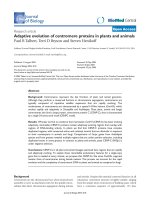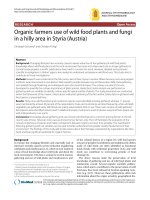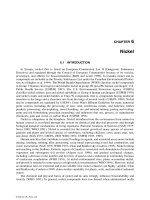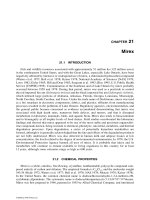4 5 4 plants and animals in antarctica
Bạn đang xem bản rút gọn của tài liệu. Xem và tải ngay bản đầy đủ của tài liệu tại đây (4.6 MB, 12 trang )
Suggested levels for Guided Reading, DRA,™
Lexile,® and Reading Recovery™ are provided
in the Pearson Scott Foresman Leveling Guide.
Life Science
Plants and
Animals in
Antarctica
Genre
Expository
nonfiction
Comprehension
Skills and Strategy
• Main Idea and
Details
• Graphic Sources
• Text Structure
Text Features
•
•
•
•
by Christine Wolf
Captions
Map
Heads
Diagram
Scott Foresman Reading Street 4.5.4
ISBN 0-328-13481-3
ì<(sk$m)=bdeibg< +^-Ä-U-Ä-U
Reader Response
1. A main idea of one section of this book is that
some plants and animals have adapted to the
harsh weather of Antarctica. Reread that section
to find details that support this main idea. Put
your ideas into a graphic organizer like the one
below.
Plants and
Animals in
Antarctica
Main Idea
Supporting Details
2. How does the diagram on page 16 help you
understand the important idea the author wants
to get across in this book?
3. On page 5, the author speaks of weather being
by Christine
Wolf of this word
forbidding. How
does the context
help you know what the word means? What can
you tell from its structure?
4. Why do you think this book starts and ends with
scientists studying krill in Antarctica?
Editorial Offices: Glenview, Illinois • Parsippany, New Jersey • New York, New York
Sales Offices: Needham, Massachusetts • Duluth, Georgia • Glenview, Illinois
Coppell, Texas • Ontario, California • Mesa, Arizona
Where is Antarctica?
Every effort has been made to secure permission and provide appropriate credit for
photographic material. The publisher deeply regrets any omission and pledges to
correct errors called to its attention in subsequent editions.
This ship, called the Palmer, is 308 feet long.
When loaded, it weighs more than 7,000 tons.
It is set to depart for Antarctica. This tiny fish,
called krill, is the size of your thumb.
Why are they important to each other? The
twenty-two crew members and thirty-seven
scientists on the Palmer are gathered in anticipation
of studying the krill population in Antarctica.
Where is Antarctica? Why are krill so
important to study? This book will answer these
questions and many more, as you learn about the
plants and animals in one of the loneliest places
on Earth.
Unless otherwise acknowledged, all photographs are the property of Scott Foresman,
a division of Pearson Education.
Photo locators denoted as follows: Top (T), Center (C), Bottom (B), Left (L), Right (R),
Background (Bkgd)
Cover (Bkgd) ©Wolfgang Kaehler/Corbis, (C) © Kevin Schafer/Corbis; 1 © Brandon D.
Cole/Corbis; 3 (BC) © Maria Stenzel/National Geographic/Getty Images, (BR) © Peter
Johnson/Corbis; 4 ©Royalty-Free/Corbis; 6 (TL) © Wolfgang Kaehler/Corbis, 6 (TR)
©Chris Rainier/Corbis, (Bkgd) © Rick Price/Corbis, (BC) © Martin B. Withers; Frank Lane
Picture Agency/Corbis; 7 © Lester V. Bergman/Corbis; 8 © Brandon D. Cole/Corbis; 9 (TL)
©Royalty-Free/Corbis, (BR) © Stuart Westmorland/Corbis; 10 © Kevin Schafer/Corbis; 11
©W. Perry Conway/Corbis; 12 © Peter Johnson/Corbis; 13 © Galen Rowell/Corbis; 15 (TL)
©Lester V. Bergman/Corbis, (TR) © Kevin Schafer/Corbis, (C) © Peter Johnson/Corbis,
(BL) ©W. Perry Conway/Corbis, (BR) © Stuart Westmorland/Corbis; 17 © Roger Tidman/
Corbis; 18 ©Peter Johnson/Corbis; 19 © Randy Faris/Corbis
The Palmer Sea Lab ship studies
animals in Antarctica.
ISBN: 0-328-13481-3
Copyright © Pearson Education, Inc.
All Rights Reserved. Printed in the United States of America. This publication is
protected by Copyright, and permission should be obtained from the publisher
prior to any prohibited reproduction, storage in a retrieval system, or transmission
in any form by any means, electronic, mechanical, photocopying, recording, or
likewise. For information regarding permission(s), write to: Permissions Department,
Scott Foresman, 1900 East Lake Avenue, Glenview, Illinois 60025.
2 3 4 5 6 7 8 9 10 V0G1 14 13 12 11 10 09 08 07 06 05
krill
3
What is Antarctica Like?
Antarctica is the coldest, windiest, and most
remote place on Earth. Antarctica is a continent
surrounded by oceans: the Pacific Ocean, the
Indian Ocean, and the Atlantic Ocean.
Temperatures at the center of the continent
hover between -66˚F and -76˚F. The lowest
temperature on Earth, -128.6˚F, was recorded in
Antarctica.
The land is completely covered in ice. Yet
Antarctica is considered a desert. Why? A desert
is dry land—a place that gets less than ten inches
of precipitation each year. Because Antarctica
receives less than three inches of precipitation
each year, it fits the description. In other words,
Antarctica is the coldest desert on Earth.
Antarctica has two seasons: A very long, dark
winter and a very short, bright summer. In winter,
you may see days with just one hour of sunlight.
Blizzards happen in Antarctica when raging
winds blow snow along the surface. Surface
winds can sweep up loose snow at more than 100
miles an hour. These winds cause severe blizzard
conditions that may last a week or longer.
You wouldn’t want to live in Antarctica. But
then again, you probably couldn’t live there. It’s
simply too cold and forbidding.
I N D I A N
O C E A N
P A C I F I C
O C E A N
4
ANTARCTICA
5
What Plants and Animals Live There?
In the freezing temperatures and strong winds
of Antarctica, only a few flowering plants can
survive.
Other kinds of plants, such as moss and algae,
grow in these freezing conditions. But these plants
usually grow while covered by snow and ice!
These plants are hardy—able to stand harsh
conditions. Antarctica’s creatures, like krill, need
tiny plants like these to survive.
Antarctica’s food web relies on these tiny
plants, called phytoplankton. These plants are
the primary producers of food in Antarctica.
The light and food that phytoplankton need
to grow and reproduce depend on the weather
and climate. Colder winters produce larger
phytoplankton. Warmer winters produce smaller
phytoplankton, which means less food for krill.
Later you will see how that affects Antarctica’s
other animals.
Phytoplankton
Antarctica’s plant life
6
7
Animals in Antarctica are interesting for all
their differences. Each Antarctic animal has
special body features that help it survive.
Animals in Antarctica include whales,
penguins, seals, flying birds, fish, squid, and krill.
Let’s take a closer look at the unique features
of some of Antarctica’s creatures. These features
help these animals adapt to the cold.
The amazing baleen whale
How Have Plants and Animals
Adapted to Harsh Weather?
Meet the Whales
Whales are enormous creatures. Many kinds
of whales migrate to Antarctica’s waters. Some
of these are called baleen whales. Baleen whales
fatten up on krill. They have a kind of strainer in
their mouths, called a baleen plate, that catches
the tiny fish.
The humpback whale can eat more than one
ton of krill a day. An adult blue whale eats four
or more tons of krill each day.
Baleen plates act like
kitchen strainers,
trapping krill inside
the whales’ mouths.
8
9
Penguins in Antarctica
Seals are right at home in Antarctica!
Birds That Can’t Fly: Penguins!
Did you know that penguins cannot fly? At
one time, they probably could. Today, the only
“flying” they do is through the icy water.
Penguins have a waterproof coat of
overlapping feathers. This keeps a warm layer of
air close to their bodies. A fatty layer under their
skin also helps keep penguins warm enough to
survive in freezing air and water.
10
Fast-Swimming Seals
Because of their torpedo-shaped bodies, seals
travel swiftly through the water. Their fur and
their thick layer of fat, called blubber, help keep
them warm. Seals enjoy lying on icebergs, or
huge chunks of floating ice. When they aren’t
playing in the icy Antarctic water, they pull their
bodies onto icebergs to rest. Then they heave
themselves back into the sea to play some more!
11
Antarctica’s Krill
There are very few fish in the world that can
live in the icy waters of Antarctica. Fish here
have an interesting feature: they have antifreeze
proteins in their bodies that keep them from
freezing! Most fish here are small. Antarctica’s cod
is the largest fish—it can weigh up to 200 pounds!
Krill, a tiny, shrimplike species of fish, are one of
the most important living creatures in Antarctica.
Krill are eaten by almost every animal here.
Antarctica’s fish and krill
12
13
How Do Plants and Animals
Depend on One Another?
An ecosystem is an environment and
all the living things in it. How those
living things interact with other living
things is important to the ecosystem.
Antarctica is an example of an extreme
ecosystem.
Everything, living and nonliving,
works together in this ecosystem.
Each part depends on another part
for survival. This dependence on one
another is called interdependence.
Antarctica’s ecosystem depends
on the krill population. Nearly every
animal in Antarctica—fish, penguins,
whales, and so on—eat krill. If anything
happened to the krill population, many
animals would die.
14
All living things depend
on one another.
15
This is a diagram of a food chain. Just as links
of a chain are connected, so are living things.
Every animal needs to eat to get energy.
Everything that an animal eats also needs to eat.
Choose an animal on the diagram of Antarctica’s
food chain. To find out what it eats, trace where
the arrows on the food chain lead. The food
chain shows how energy moves from one living
thing to another—then to another.
At the convergence—or center point—of this
food chain is krill. That’s how important krill are!
Most of Antarctica’s animals depend on krill for
their food. Some animals eat other things besides
krill.
Imagine what would happen if humans caught
too many fish in Antarctica. Which animals would
go hungry? What if disease wiped out the krill
population? What would happen then?
ANTARCTICA’S FOOD CHAIN
A
B
A EATS B
SMALL PLANTS
THAT FLOAT ON
THE SEA SURFACE
PHYTOPLANKTON
KRILL
Krill
SEALS
FISH
PENGUINS
TOOTHLESS
WHALES
TOOTHED WHALES
16
17
Scientists in Antarctica today are very worried
about the krill population. It seems to be getting
smaller. They think it might be because the Earth
seems to be getting warmer. We call this global
warming.
Global warming slowly melts the sea ice. As
this happens, the phytoplankton and algae that
live in the sea ice die off. Without algae and
phytoplankton, krill have nothing to eat. So as
the Earth warms up, the krill die.
If krill keep dying, the animals that depend on
krill for food might die, too. Scientists are trying
to find ways to keep the krill population strong.
Antarctica: A Forbidding Environment
Antarctica’s climate makes it a forbidding
place to live. Only the strongest and most welladapted plants and animals can survive in such a
severe ecosystem.
That’s why scientists are doing all they can to
study this incredible area. They want Antarctica
to survive!
Antarctica’s Landscape
Global warming melts
precious sea ice.
18
19
Glossary
Reader Response
anticipation n. act of
looking forward to;
expectation.
forbidding adj.
unpleasant; threatening
or menacing.
continent n. one of the
seven great land masses
on Earth.
heave v. to raise or lift
with great effort or
force.
convergence n. act of
meeting at a point.
icebergs n. massive
chunks of floating ice.
1. A main idea of one section of this book is that
some plants and animals have adapted to the
harsh weather of Antarctica. Reread that section
to find details that support this main idea. Put
your ideas into a graphic organizer like the one
below.
Main Idea
depart v. to go away.
Supporting Details
2. How does the diagram on page 16 help you
understand the important idea the author wants
to get across in this book?
3. On page 5, the author speaks of weather being
forbidding. How does the context of this word
help you know what the word means? What can
you tell from its structure?
4. Why do you think this book starts and ends with
scientists studying krill in Antarctica?
20









